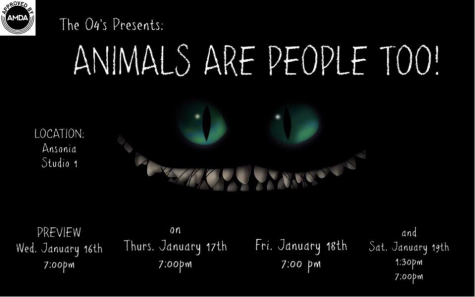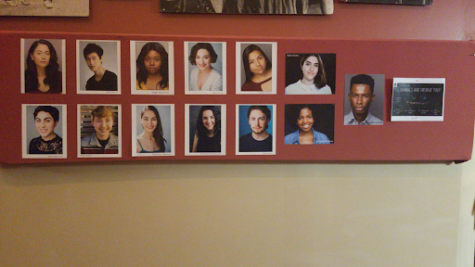Review of AMDA’s Animals Are People Too
February 22, 2019
The American Musical and Dramatic Academy is a two-year college that creates actors of immense talent. For example, two stars of the famous show Hamilton, Anthony Ramos and Christopher Jackson, are alumni of AMDA. For this reason and more, when Ophir Hudes invited me and my family to her group’s showcase, Animals Are People Too, I was quite excited. The resulting performance more than exceeded my expectations.

The performance was a collection of scenes rather than a single play, and the quick, dramatic character switches showed off the talent in the actors. It featured a small group of students, the O4, hailing from all parts of the United States and beyond. The performance was at the Ansonia, a beautiful residential hotel in NYC, which only added to the experience.

The sets were minimal— a park bench, a table, a fake tree; but the stage never felt barren. From a dog clearly running around somewhere off stage though the actor (Anita Samoylovich) only held a torn leash, to a Russian woman (Drew Hughes) warming her hands in a fire that never existed, the actors created a fully visible set from thin air.
It would seem difficult to convey in-depth characterization in such short scenes, but the actors were able to do this in the showcase. Though no character development could take place, all characters had a clear personality. In the case of a scene from Marion Bridge, a dark and heavy past hangs over the characters portrayed only outside of the dialogue: the way Agnes (Ophir Hudes) would take another swig from her glass of liquor, or the expression on the face of Louise (Lindsay Cahill).

The actors were not the only ones to add to the effect of the showcase. Even the stage crew seemed to be involved in the performance. At points, one could see the black-clothed people bringing out fake trees before dancing off to the backstage, which gave the audience a laugh before the scene had even started. The organization of the scenes too played a role in the effect. A short scene, The Glory of Living, taking place over an extended period of time, followed a young girl on death row. It was broken up into two parts with a different scene in the middle to represent the time gap. In doing this, the production stepped outside of standard scene anthology formats and it worked very well. That scene weighed on the audience from the moment it began to the moment it faded out with the loud music of a small piano. The production also balanced humor and heaviness very well with humorous scenes such as Stay Carl Stay, Androcles and the Lion, and As You Like It with heavier scenes such as This Property is Condemned, The Glory of Living, and Marion Bridge.
One of the heaviest scenes was This Property is Condemned by Tennessee Williams. It shows Willie (Vanessa Pluviose), a girl whose family is dead or gone and lives in a condemned property, talking to a regular kid, Tom (Diallo Hairston). At first, Willie seems confident as she balances on the old train tracks she knows by heart and speaks of the glorious life she will lead. She seems sad, however, as she continually talks about her late sister. As she continues to talk, her lines begin repeating themselves. As she repeats her points again and again whilst still maintaining an air of confidence, the audience is left severely unsettled. As Willie walks offstage–still singing the same few lines of her sister Alva’s favorite song–the storm mentioned by Tom seems to settle over the crowd.
On the other hand, one of the best comedies included was Stay Carl Stay by Peter Tolan. This follows Caroline (Samantha Stratmeyer) who gets a dog at the recommendation of her therapist (Ophir Hudes). She teaches the dog, Carl (Liam Zupp), how to speak, and they begin dating. Right from the get-go with a human playing the canine lead, the audience was amused. But when he began learning English, he had the audience in stitches. By the end of the excerpt, the pair are in couples therapy. The scene was effective due to its use of dialogue in combination with imagined reality. Zupp was a dog plain and simple, despite speaking English and wearing normal human clothing. This also allowed the dating thing to be funny rather than weird.
As the final scene, The Rose Tattoo, ended, random characters in now ill-fitting costumes came dancing onto the stage; the woman in a long Victorian dress was alongside the Italian lady in a frock and the Roman man in a long flowing tunic. The actors had assembled and were dancing with each other as whatever character they had played last as they took their bows. This was a very creative and amusing way of ending the show, and it worked very well.
I cannot fairly compare a student showcase made up of functionally unconnected scenes to other performances due to their very different natures, but I would highly rate the production for what it was. It featured a fluid combination of drama and comedy that worked well. The actors were able to create a developed atmosphere. I will certainly expect to see those students names at some point in the future, be it in movies or on Broadway.
If you are interested in seeing an AMDA performance, you can find out about future performances by emailing [email protected].

